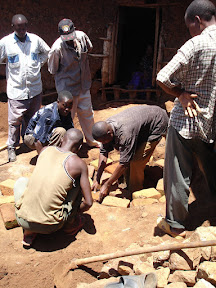(Note: I've put some more pictures up of the finished catchment at Marabe's home. I'll also be making an addition to my posting schedule. Every WEDNESDAY I will be writing a cultural post about Kuria, Kenya. Many of you have asked for a better picture of what life is like here for both me and the locals. I'll do my best to give you an idea by describing foods, customs, and even some language lessons. Thanks for your feedback, it helps me improve my blog!)
The week began at Marabe's home putting his tank on the cured foundation and finishing off the piping into the tank from the gutters. We skipped putting the cement on the pipe joints because I wanted to see how the system would perform before making it too permanent. In the afternoon we headed to John's where we were hoping to quickly put up his gutters. It wasn't as quick as we had hoped.
We had the good fortune at Marabe's home that his whole compound sloped where we put the gutters. Because of the slope, we didn't have to worry too much about the slope of the gutters relative to the roof, we just made sure the rain would fall in from the roof. The roof we placed the catchment on for John's roof was another story. His catchment roof was at the top of his compound and the roof was essentially level to the ground. It's great for construction but terrible for catchments.
The process for placing gutters is first nailing up the fascia board, then checking the slope of the roof, placing gutter clips, and sliding in the gutters. Our estimation of the slope showed us that we could achieve the desired slope but the placement of the gutter clips is a little difficult. The clips are exactly examples of precision manufacturing so there is some variation in their shape. The fascia boards also rest against tree limbs so some of them curve more towards the ground than others, changing the gutter position even if the gutter clips are in the proper place. So with these factors all combined, we ended up putting up gutters that flowed backwards in some parts causing pretty big leaks. After some thinking and reanalyzing, we decided to slope the gutters towards the middle instead of one side. This gave us more room for a steeper slope from side to side. It took quite a while to put in the gutter clips, find out we messed up, pull out the clips, and then put them back in for our new configuration. But we got it done at the end of the day and the gutters work great!
On Tuesday we put in the foundation at John's home. Originally the plan was for the leaders to put the foundation in themselves but they got cold feet and we had the fundi help us out again. The process was a little slower than Marabe's because some of the material was missing but John was able to pick it up in time for us to finish. We put up the drain box and the piping to divert the rain from the foundation so it wouldn't be damaged if it rained.
Lucas and I also took a trip up to Migori to pick up the 4" plugs we will be installing on the first flush pipes so that the leaders can unscrew the pipes after the rain is over to flush out the dirty water in the pipe. We also ordered six more drain boxes made by the local fundi but they weren't yet ready.
Wednesday we moved on to Pauline's to place the gutters. It was quite a challenge because her roof beams where we were nailing the fascia were not lined up down the entire length of the roof. But, the roof was sloped similar to Marabe's so we lucked out on having an easier time placing the gutters. The plan was to do the gutters in the morning and the foundation in the afternoon but after finishing the gutters it didn't look like we would have time to do the base as well. Also, since the leaders were going to try the foundation themselves this time I didn't want to rush them.
Thursday the leaders took a big step in constructing the foundation themselves with the fundi supervising. Pauline's foundation went pretty smoothly although it was pretty obvious it wasn't a fundi job. It's ok, the team is still learning. The fundi stepped in at the end because the leaders were having a little trouble with plastering where you trow cement on the outside verticle surfaces to finish it off in a coat of weather proof cement. There was a sense of pride in the air after finishing the foundation. The team was really pumped.
Friday we headed back to John's to finish off the John's catchment with his now cured foundation much in the same way we finished Marabe's on Monday. Afterward we had a meeting getting everyone's opinions on the progress and discussing how we can improve as we go forward. It was also the first time the leaders found out about the plan to have an open house once all of the catchments are complete. We will be having the leaders invite their w+s representatives, about ten each, to their homes to see what the catchments look like. It'll be a great chance to get the word out to the larger community about the catchments as well as giving the leaders the opportunity to lead.
All in all a good week with some "office" work getting done on Saturday at home. 2.9 catchments down, 3.1 to go.
twelve new pictures
 |  |  |  |
 |  |  |  |
 |  |  |  |








































